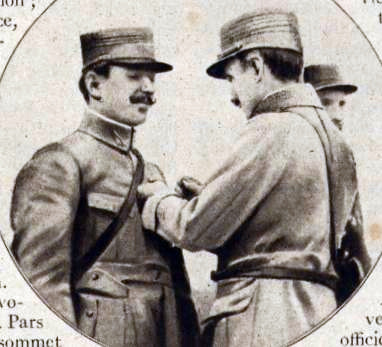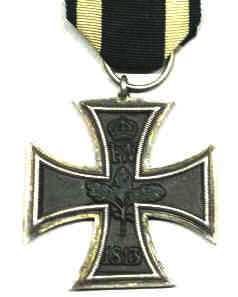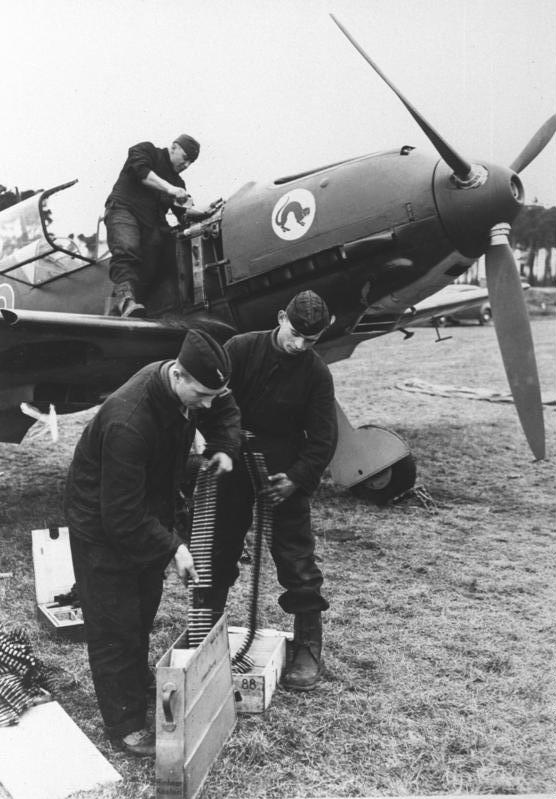|
Karl-Gottfried Nordmann
Karl-Gottfried "Karlfried" Nordmann (22 November 1915 – 22 July 1982) was a German Luftwaffe pilot during World War II and, after the war, a president of Mercedes-Benz in North America. As a fighter ace he was credited with 78 enemy aircraft shot down in over 800 combat missions. He claimed the majority of his victories over the Eastern Front, with one during the Invasion of Poland and eight during the Battle of France and Britain. Born in Giessen, Nordmann volunteered for military service in the Luftwaffe of the Third Reich in 1936. Following flight training, he was posted to ''Jagdgeschwader'' 132 (JG 132—132nd Fighter Wing) in October 1938. After a series of redesignations his unit was subordinated to ''Jagdgeschwader'' 51 (JG 51—51st Fighter Wing). He fought in the aerial battles over Poland, France and Britain, claiming nine victories. Following the German invasion of the Soviet Union in Operation Barbarossa, he was appointed ''Gruppenkommandeur'' (group commander) ... [...More Info...] [...Related Items...] OR: [Wikipedia] [Google] [Baidu] |
President (corporate Title)
A president is a leader of an organization, company, community, club, trade union, university or other group. The relationship between a president and a chief executive officer varies, depending on the structure of the specific organization. In a similar vein to a chief operating officer, the title of corporate president as a separate position (as opposed to being combined with a " C-suite" designation, such as "president and chief executive officer" or "president and chief operating officer") is also loosely defined; the president is usually the legally recognized highest rank of corporate officer, ranking above the various vice presidents (including senior vice president and executive vice president), but on its own generally considered subordinate, in practice, to the CEO. The powers of a president vary widely across organizations and such powers come from specific authorization in the bylaws like '' Robert's Rules of Order'' (e.g. the president can make an "executive decision ... [...More Info...] [...Related Items...] OR: [Wikipedia] [Google] [Baidu] |
Fighter Ace
A flying ace, fighter ace or air ace is a military aviator credited with shooting down five or more enemy aircraft during aerial combat. The exact number of aerial victories required to officially qualify as an ace is varied, but is usually considered to be five or more. The concept of the "ace" emerged in 1915 during World War I, at the same time as aerial dogfighting. It was a propaganda term intended to provide the home front with a cult of the hero in what was otherwise a war of attrition. The individual actions of aces were widely reported and the image was disseminated of the ace as a chivalrous knight reminiscent of a bygone era. For a brief early period when air-to-air combat was just being invented, the exceptionally skilled pilot could shape the battle in the skies. For most of the war, however, the image of the ace had little to do with the reality of air warfare, in which fighters fought in formation and air superiority depended heavily on the relative availability ... [...More Info...] [...Related Items...] OR: [Wikipedia] [Google] [Baidu] |
Jagdfliegerführer Ostpreussen
Jagdfliegerführer OstpreußenA Jagdfliegerführer, or Jafü, was the commander of the Fighter forces of a ''Luftflotte''. For more details see Luftwaffe Organization was initially part of 1st Fighter Division of the German Luftwaffe in World War II. It was formed 15 September 1943 in Neuhausen. On 8 September 1944 the '' Stab'' relocated to Königsberg-Seewiesen and subordinated to the Luftflotte 6 (Air Fleet 6) in January 1945. The ''Stab'' relocated again on 27 February 1945, this time to Treuenbrietzen. The unit was disbanded on 27 February 1945. Commanding officers Fliegerführer *Oberstleutnant Karl-Gottfried Nordmann Karl-Gottfried "Karlfried" Nordmann (22 November 1915 – 22 July 1982) was a German Luftwaffe pilot during World War II and, after the war, a president of Mercedes-Benz in North America. As a fighter ace he was credited with 78 enemy aircraft ..., 1 April 1944 *Hauptmann Egbert Belau, 1 October 1944 References ;Notes ;References Jagdfliegerführer Ostp ... [...More Info...] [...Related Items...] OR: [Wikipedia] [Google] [Baidu] |
Midair Collision
In aviation, a mid-air collision is an accident in which two or more aircraft come into unplanned contact during flight. Owing to the relatively high velocities involved and the likelihood of subsequent impact with the ground or sea, very severe damage or the total destruction of at least one of the aircraft usually results. The potential for a mid-air collision is increased by miscommunication, mistrust, error in navigation, deviations from flight plans, lack of situational awareness, and the lack of collision-avoidance systems. Although a rare occurrence in general due to the vastness of open space available, collisions often happen near or at airports, where large volumes of aircraft are spaced more closely than in general flight. First recorded mid-air collision The first recorded collision between aircraft occurred at the "Milano Circuito Aereo Internazionale" meeting held between 24 September and 3 October 1910 in Milan, Italy. On 3 October, Frenchman René Thomas, fly ... [...More Info...] [...Related Items...] OR: [Wikipedia] [Google] [Baidu] |
Geschwaderkommodore
{{unreferenced, date=May 2019 ''Geschwaderkommodore'' (short also ''Kommodore'') is a ''Luftwaffe'' position or appointment (not rank), originating during World War II. A ''Geschwaderkommodore'' is usually an OF5-rank of ''Oberst'' (colonel) or Kapitän zur See (naval captain). A ''Geschwaderkommodore'' will command a ''Geschwader'' (Wing), which in turn contains ''Gruppen'' ( Groups) each commanded by a ''Gruppenkommandeur'' (Group Commander). See also * Organization of the Luftwaffe (1933–1945) Between 1933 and 1945, the organization of the Luftwaffe underwent several changes. Originally, the German military high command, for their air warfare forces, decided to use an organizational structure similar to the army and navy, treating the ... Luftwaffe Air force appointments German Air Force ... [...More Info...] [...Related Items...] OR: [Wikipedia] [Google] [Baidu] |
Adolf Galland
Adolf Josef Ferdinand Galland (19 March 1912 – 9 February 1996) was a German Luftwaffe general and flying ace who served throughout the Second World War in Europe. He flew 705 combat missions, and fought on the Western Front and in the Defence of the Reich. On four occasions, he survived being shot down, and he was credited with 104 aerial victories, all of them against the Western Allies. Galland, who was born in Westerholt, Westphalia became a glider pilot in 1929 before he joined the Luft Hansa. In 1932, he graduated as a pilot at the ''Deutsche Verkehrsfliegerschule'' (German Commercial Flyers' School) in Braunschweig before applying to join the Reichswehr of the Weimar Republic later in the year. Galland's application was accepted, but he never took up the offer. In February 1934, he was transferred to the Luftwaffe. In 1937, during the Spanish Civil War, he volunteered for the Condor Legion and flew ground attack missions in support of the Nationalists under Franci ... [...More Info...] [...Related Items...] OR: [Wikipedia] [Google] [Baidu] |
Knight's Cross Of The Iron Cross With Oak Leaves And Swords
The Knight's Cross of the Iron Cross (german: Ritterkreuz des Eisernen Kreuzes), or simply the Knight's Cross (), and its variants, were the highest awards in the military and paramilitary forces of Nazi Germany during World War II. The Knight's Cross was awarded for a wide range of reasons and across all ranks, from a senior commander for skilled leadership of his troops in battle to a low-ranking soldier for a single act of military valour. Presentations were made to members of the three military branches of the : the (army), the (navy) and the (air force), as well as the , the Reich Labour Service and the (German People storm militia), along with personnel from other Axis powers. The award was instituted on 1 September 1939, at the onset of the German invasion of Poland. The award was created to replace the many older merit and bravery neck awards of the German Empire. A higher grade, the Oak Leaves to the Knight's Cross, was instituted in 1940. In 1941, two higher grades ... [...More Info...] [...Related Items...] OR: [Wikipedia] [Google] [Baidu] |
Grand Cross Of The Iron Cross
The Grand Cross of the Iron Cross (german: Großkreuz des Eisernen Kreuzes) was a decoration intended for victorious generals of the Prussian Army and its allies. It was the second highest class of the Iron Cross, following the Star of the Grand Cross of the Iron Cross, which was awarded only twice. Along with the Iron Cross 1st and 2nd Class, the Grand Cross was founded on 10 March 1813, during the Napoleonic Wars. It was renewed in 1870 for the Franco-Prussian War and again in 1914 for World War I. In 1939, when Adolf Hitler renewed the Iron Cross as a German (rather than strictly Prussian) decoration, he also renewed the Grand Cross. The Grand Cross of the Iron Cross was twice the size of the Iron Cross and was worn from a ribbon around the neck. The later Knight's Cross of the Iron Cross, instituted in 1939, was also worn from the neck; it was smaller than the Grand Cross but larger than the Iron Cross. 1813 Grand Cross File:Blücher (nach Gebauer).jpg, ''Generalfeldmar ... [...More Info...] [...Related Items...] OR: [Wikipedia] [Google] [Baidu] |
Knight's Cross Of The Iron Cross
The Knight's Cross of the Iron Cross (german: Ritterkreuz des Eisernen Kreuzes), or simply the Knight's Cross (), and its variants, were the highest awards in the military and paramilitary forces of Nazi Germany during World War II. The Knight's Cross was awarded for a wide range of reasons and across all ranks, from a senior commander for skilled leadership of his troops in battle to a low-ranking soldier for a single act of military valour. Presentations were made to members of the three military branches of the : the (army), the (navy) and the (air force), as well as the , the Reich Labour Service and the (German People storm militia), along with personnel from other Axis powers. The award was instituted on 1 September 1939, at the onset of the German invasion of Poland. The award was created to replace the many older merit and bravery neck awards of the German Empire. A higher grade, the Oak Leaves to the Knight's Cross, was instituted in 1940. In 1941, two higher grade ... [...More Info...] [...Related Items...] OR: [Wikipedia] [Google] [Baidu] |
Organization Of The Luftwaffe (1933–1945)
Between 1933 and 1945, the organization of the Luftwaffe underwent several changes. Originally, the German military high command, for their air warfare forces, decided to use an organizational structure similar to the army and navy, treating the aviation branch as a strategic weapon of war. Later on, during the period of rapid rearmament, the Luftwaffe was organized more in a geographical fashion. Under the terms of the Treaty of Versailles (1919), Germany was prohibited from having an air force, with the former German Empire's ''Luftstreitkräfte'' disbandment in 1920. German pilots were secretly trained for military aviation, first in the Soviet Union during the late 1920s, and then in Germany in the early 1930s. In Germany, the training was done under the guise of the German Air Sports Association (german: Deutscher Luftsportverband (DLV)) at the Central Commercial Pilots School (german: Zentrale der Verkehrs Fliegerschule (ZVF)). Following its 15 May 1933 formation in secre ... [...More Info...] [...Related Items...] OR: [Wikipedia] [Google] [Baidu] |
Gruppenkommandeur
''Gruppenkommandeur'' is a Luftwaffe position (not rank), that is the equivalent of a commander of a group or wing in other air forces. A ''Gruppenkommandeur'' usually has the rank of Major or '' Oberstleutnant'' (Lieutenant Colonel), and commands a '' Gruppe'', which is a sub-unit of a ''Geschwader This is a list of words, terms, concepts, and slogans that have been or are used by the German military. Ranks and translations of nicknames for vehicles are included. Also included are some general terms from the German language found frequently i ...''. A ''Gruppe'' usually consists of three or four '' Staffeln'' (each of which is commanded by a '' Staffelkapitän''). See also * Organization of the Luftwaffe (1933–1945) Military ranks of Germany Luftwaffe Air force appointments {{aviation-stub ... [...More Info...] [...Related Items...] OR: [Wikipedia] [Google] [Baidu] |
Jagdgeschwader 51
''Jagdgeschwader'' 51 (JG 51) was a German fighter wing during World War II. JG 51's pilots won more awards than any other fighter wing of the Luftwaffe, and operated in all major theatres of war. Its members included Anton Hafner, Heinz Bär, Karl-Gottfried Nordmann, and Günther Schack. World War II Formed in August 1939 and commanded by Theo Osterkamp, JG 51 was based in the early months of the war in the West, fighting in the Battle of France and the Battle of Britain. From late June 1940 to mid July 1940, JG 51 was the only fighter Geschwader engaged continuously against the RAF. During the battle JG 51 lost 68 pilots, the highest casualty rate of the Luftwaffe fighter units engaged. From 12 July 1940 until November 1940, Stab JG 51 was located at Saint-Inglevert Airfield in Saint-Inglevert, France. Major Werner Mölders became the unit's commander in July 1940 and led the unit during the invasion of the Soviet Union in June 1941. During Operation Barbarossa, JG ... [...More Info...] [...Related Items...] OR: [Wikipedia] [Google] [Baidu] |






